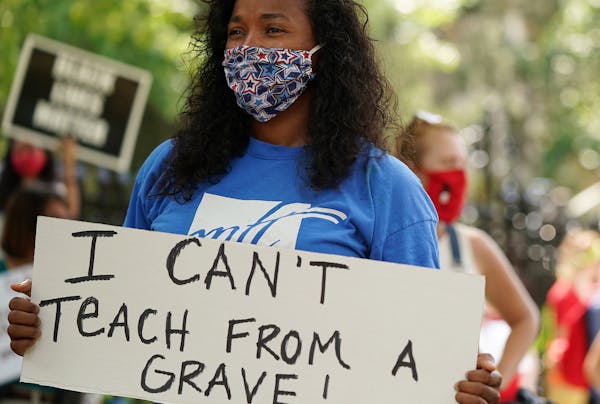Centers for Disease Control and Prevention Director Robert Redfield says communities need to take steps to minimize the spread of the virus that causes COVID-19 so that schools can reopen this fall.
"We need communities to adopt the actions to slow the spread of COVID now," Redfield said Friday on a call with reporters. "We owe it to our nation's children to take personal responsibility, do everything we can to lower the levels of COVID-19 so they can go back to school safely."
Redfield's comments come after the CDC late Thursday released its updated guidance for schools considering how to reopen. The guidance was compiled by several agencies, including the CDC, Department of Education and Department of Labor, and was reviewed by the White House Office of Management and Budget, as interagency guidelines typically are, Redfield said.
A CDC statement discusses the "importance" of reopening schools, noting that school-age children are less likely to get sick from the virus and death rates in that age group are far lower than among adults. It says students could be set back in many areas of life if schools remain closed.
The writing of that memo was led by the Department of Health and Human Services, with input from the CDC and agencies, including the Substance Abuse and Mental Health Services Administration, Redfield said.
Mitchell Zais, the deputy secretary of education, said on the call Friday that the "default" should be schools fully open this fall.
"In areas where there are hot spots, remote distancing learning might need to be adopted for a certain amount of time, but the research and science continue to suggest that it is safer, healthier and better for students to be in school full time," said Zais.
Anthony Fauci, the director of the National Institutes of Allergy and Infectious Diseases, called the memo "a sound set of guidelines" during a live interview Friday with the Washington Post.
This week's guidelines come after President Donald Trump criticized earlier guidance from the agency as too restrictive. Trump has threatened to cut off federal funding for schools that don't reopen this fall. Meanwhile, Congress is preparing to provide billions more dollars for schools as lawmakers craft another aid package responding to the health and economic effects of the pandemic.
A CDC document released Thursday details what sorts of mitigation steps schools should take to minimize the spread of the virus.
Schools should consider what the level of virus transmission is in the community, and consider stopping on-site operations if officials see substantial, uncontrolled spread, the guidance says. In addition to strategies to limit the spread of the virus — such as social distancing, wearing masks and washing hands and practicing proper hygiene — schools may also consider cohorting, or keeping small groups of students together throughout the day, and staggering when students arrive at school to limit the number of people who interact with each other.
Schools should also consider taking steps to limit the virus's spread during extracurricular and co-curricular activities, which may include limiting or canceling activities in some cases.
Redfield said it was important to reopen schools "with the understanding that COVID is still here."
Schools should develop plans for what to do when a staff member or student gets sick, such as whether and how long to close the school in the case of an outbreak. There should also be plans for how long students and staff who test positive for the virus, or have been in close contact with someone who has, need to self-isolate or quarantine.
Redfield said the "knee-jerk" answer to close a school when there's a single case there isn't the best approach.
We "gave guidance in terms of how to begin to respond when a student, for example, develops symptoms or when a student is confirmed to be COVID-positive, what is the appropriate response within that classroom, within that school," he said.

University of Minnesota police arrest 9 after pro-Palestinian encampment set up on campus
2 dead in Lino Lakes, no known threat to public, police say
Teen charged with murder in deadly St. Paul shooting last month

